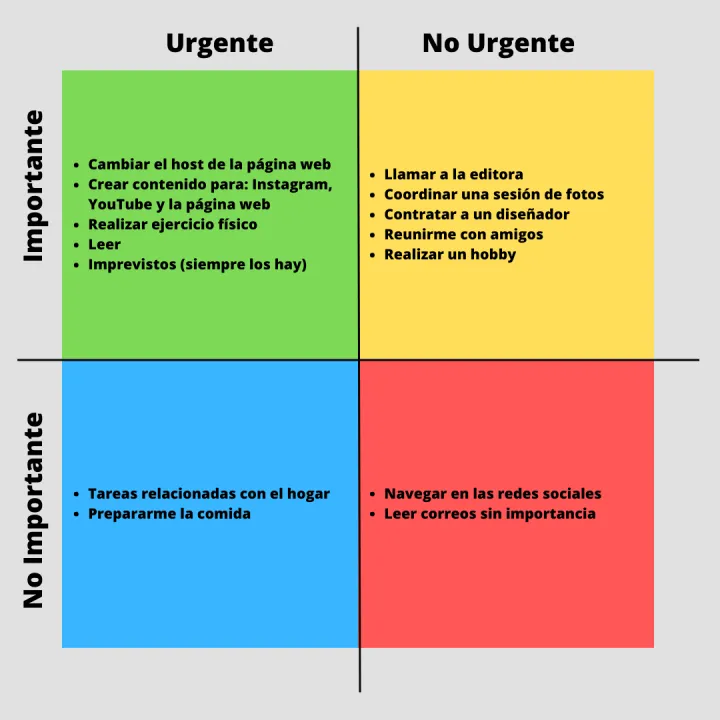Para tener una mejor gestión del tiempo es importante que prioricemos las tareas que realizamos y hoy quiero compartir contigo la matriz de Eisenhower que nos permitirá trabajar en la priorización de tareas y es aplicable a cualquier ámbito de nuestras vidas.
To have better time management it is important that we prioritize the tasks we perform and today I want to share with you the Eisenhower matrix that will allow us to work on prioritizing tasks and is applicable to any area of our lives.

LINK
Para entender: esta matriz es una herramienta que nos permite gestionar las tareas organizándolas conforme a su importancia y urgencia, con esta herramienta se pueden dividir las tareas en cuatro cuadrantes conforme a las tareas que harás primero y cuales harás después, las tareas que podrás delegar y aquellas que puedes eliminar ya que de alguna manera son simplemente una pérdida de tiempo.
To understand: this matrix is a tool that allows us to manage tasks by organizing them according to their importance and urgency, with this tool you can divide tasks into four quadrants according to which tasks you will do first and which you will do later, the tasks that you can delegate and those that you can eliminate since in some way they are simply a waste of time.
Para iniciar el trabajo con este cuadrante de prioridades se necesita hacer una lista de las tareas pendientes, después de esto procesándolo otra vez de esta matriz de Eisenhower podemos distinguir muy claramente cuáles son las tareas importantes y urgentes Y así podemos organizar la jornada y el flujo de trabajo. Eso es lo que aprenderemos a continuación.
To start working with this quadrant of priorities, you need to make a list of the pending tasks. After this, by processing this Eisenhower matrix again, we can distinguish very clearly which are the important and urgent tasks. And so we can organize the day and workflow. That is what we will learn next.
Se presenta una pregunta muy interesante ¿cuál es la diferencia entre las tareas urgentes e importantes? Cuando aprendes a diferenciar estos dos tipos de tareas tienes casi todo resuelto ya que es fundamental hacer esta diferencia, nos ayuda a identificar aquellas tareas en las cuales debemos enfocarnos y cuales podemos abordarlas en otro momento. Por ejemplo: las tareas urgentes son aquellas que deben ser atendida de forma inmediata, si estas tareas no las realizamos ahora podremos enfrentar consecuencias específicas, sobre todo si no terminamos dichas tareas en un tiempo específico, estas son aquellas tareas que no se pueden evitar, un ejemplo pueden ser: la finalización de un trabajo un proyecto en una fecha y una hora específica, la atención urgente de un cliente o por ejemplo reparar un caño de agua que se ha roto, estos son algunos casos que requieren atención inmediata.
A very interesting question arises: what is the difference between urgent and important tasks? When you learn to differentiate these two types of tasks, you have almost everything solved since it is essential to make this difference, it helps us identify those tasks on which we should focus and which we can address at another time. For example: urgent tasks are those that must be attended to immediately, if we do not carry out these tasks now we may face specific consequences, especially if we do not finish these tasks in a specific time, these are those tasks that cannot be avoided, An example could be: the completion of a job, a project on a specific date and time, the urgent attention of a client or, for example, repairing a water pipe that has broken, these are some cases that require immediate attention.
DESCARGA LA PLANTILLA
En el caso de las tareas importantes, nos referimos a aquellas que no deben ser necesariamente atendidas de manera inmediata pero si atenderlas nos permiten lograr nuestros objetivos a largo plazo. Si bien estas son tareas que no son urgente pero si son importante y debemos planificar llevarlas a cabo para que utilicemos de manera eficiente nuestros recursos, algunos ejemplos podrían ser: trabajar con una base de datos de clientes, realizar trabajos de mantenimiento en determinado sector, éstas tareas si deben ser llevadas a cabo pero no necesariamente de forma inmediata. Una vez que identifiques estos dos tipos de tarea puedes iniciar el trabajo con el cuadrante de Eisenhower.
In the case of important tasks, we refer to those that do not necessarily need to be attended to immediately but addressing them allows us to achieve our long-term objectives. Although these are tasks that are not urgent, but they are important and we must plan to carry them out so that we use our resources efficiently, some examples could be: working with a customer database, performing maintenance work in a certain sector, These tasks must be carried out but not necessarily immediately. Once you identify these two types of tasks you can start working with the Eisenhower quadrant.
Cuadrante 1 (IMPORTANTE Y URGENTE)
este cuadrante podemos denominar lo del cuadrante del hacer ya que aquí se colocan las tareas urgentes e importantes, cuando recorremos toda nuestra lista de pendientes aquí colocaremos aquellas que deben hacerse en este mismo momento y que si no la realizamos tienen consecuencias muy claras afectando hacia nuestros objetivos. Las tareas que se coloquen aquí son generalmente aquellas de las cuales no tenemos ninguna duda porque son las primeras que se vienen a nuestra mente y son las que causan mayor estrés como también causantes de la procrastinación.
Quadrant 1 (IMPORTANT AND URGENT)
We can call this quadrant the do quadrant since urgent and important tasks are placed here. When we go through our entire to-do list, here we will place those that must be done at this very moment and that if we do not do them, they have very serious consequences. clearly affecting our objectives. The tasks that are placed here are generally those that we have no doubt about because they are the first that come to our mind and are the ones that cause the most stress as well as causing procrastination.
Cuadrante 2 (IMPORTANTE NO URGENTE)
en este cuadrante podemos colocar aquellas tareas que no son urgentes pero si tienen gran nivel de importancia, éstas serían las tareas que afectarían a nuestros objetivos a largo plazo pero no necesariamente debemos realizarla inmediatamente. Éste cuadrante debe ser completado después del primer cuadrante.
Quadrant 2 (IMPORTANT NOT URGENT)
In this quadrant we can place those tasks that are not urgent but have a high level of importance, these would be the tasks that would affect our long-term objectives but we do not necessarily have to do them immediately. This quadrant must be completed after the first quadrant.
Cuadrante 3 (URGENTE NO IMPORTANTE)
aquí podemos colocar aquellas tareas que podremos delegar ya que son tareas urgentes pero no importante. Estas tareas si bien se tienen que realizar ahora no afectan a nuestros objetivos a largo plazo. Estas tareas generalmente son las que no tenemos las habilidades específicas para poder realizarla y es por ello que podemos delegarlas a otros miembros del equipo para que se realicen.
Quadrant 3 (URGENT NOT IMPORTANT)
Here we can place those tasks that we can delegate since they are urgent but not important tasks. These tasks, although they have to be done now, do not affect our long-term objectives. These tasks are generally ones that we do not have the specific skills to perform and that is why we can delegate them to other team members to carry them out.
Cuadrante 4 (NO URGENTE NO IMPORTANTE)
después de haber completado los tres cuadrantes anteriores debemos completar este último. Aquí se completarán las tareas que no pertenecen ninguno de los tres cuadrantes anteriores, esto quiere decir que son las tareas que no son importante y tampoco urgente. Generalmente estas tareas sean de poca importancia y que solamente generan distracciones, son un obstáculo para lograr nuestros objetivos, simplemente estas tareas debemos eliminarlas.
Quadrant 4 (NOT URGENT NOT IMPORTANT)
after having completed the previous three quadrants we must complete this last one. Here the tasks that do not belong to any of the previous three quadrants will be completed, this means that they are the tasks that are not important or urgent. Generally these tasks are of little importance and only generate distractions, they are an obstacle to achieving our objectives, we must simply eliminate these tasks.
Espero que de esta manera puedas poner en práctica el uso de este cuadrante de prioridades, estoy seguro que te ayudará a priorizar las tareas y hacer mucho más productivos sin estrés y eliminando poco a poco el hábito de procrastinación y así lograr tus objetivos.
I hope that in this way you can put into practice the use of this priority quadrant, I am sure that it will help you prioritize tasks and be much more productive without stress and gradually eliminating the habit of procrastination and thus achieving your goals. goals.
Lo relatado en esta publicación es 100% de mi autoría, ha salido de mi cerebro por mi experiencia, fracasos y estudio de distintas fuentes. Cualquiera que quiera tomar parte de este relato puede solicitar el permiso correspondiente para hacerlo.
Mis logros.


